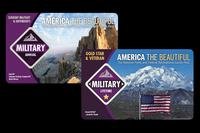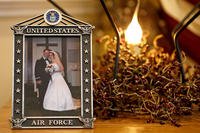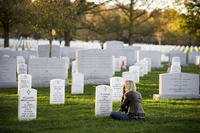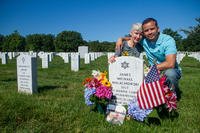For eight agonizing months, Alleta Sullivan clung to the slimmest of hopes that her five sons somehow survived the sinking of the USS Juneau in late 1942.
When Navy Secretary Frank Knox officially declared the warship's 687 missing sailors and officers dead in August 1943, Sullivan -- who reportedly battled depression earlier in her life -- could have easily fallen into a tailspin of despair. Instead, even before Knox’s confirmation, she had already been doing what her sons would have wanted.
She and her husband, Thomas, were supporting the war effort the best they knew how while coping with any parent’s worst nightmare -- five times over.
"The boys always wrote me to 'keep my chin up,'" Alleta Sullivan once said. "After their ship went down, I remembered what they said and made up my mind to see what I can do to help win the war -- to kind of carry on for their sake."

Despite the largest loss of life sustained by one family in the U.S. Navy's history, Alleta and Thomas were determined to honor their sons' memory. Their eldest boys, George and Frank, served in the Navy from 1937 to 1941 and were out of the service when the Japanese attacked Pearl Harbor on Dec. 7, 1941, precipitating the United States' entry into World War II. The surprise bombing killed a close family friend stationed on the USS Arizona, prompting not only George and Frank to reenlist but also their brothers -- Joseph, Madison (also known as Matt) and Al -- to join the military to help avenge his death.
The brothers were best friends who enjoyed nothing more than spending time together. Even though the Navy usually separated brothers during wartime, it was not strictly enforced so the sea service relented when the Sullivans insisted on serving on the same ship. The brothers were assigned to the USS Juneau, a recently commissioned light cruiser that -- as part of a task force of naval vessels -- was sent to support the Marines at Guadalcanal in the Solomon Islands.
The Juneau arrived there on Nov. 12, 1942, and early the next morning, a Japanese submarine fired a torpedo intended for the USS San Francisco, a heavy cruiser. It struck the Juneau instead, killing 17 sailors and severely damaging its keel. The crew rushed to fix as much damage as possible, and although the warship was down 12 feet by the bow, it rejoined other naval ships as they made their way to the Allied military base at Espiritu Santo for more repairs.
En route there, the Japanese attacked again shortly before noon on Nov. 13. They fired four more torpedoes at the San Francisco, all of which missed their intended target. One of the missiles, though, tore through the Juneau with catastrophic results. The battered cruiser sank in less than 20 seconds as pieces of the cruiser and body parts shot into the air. Some debris landed a half-mile away.

Frank, Joseph and Matt Sullivan died instantly, and Al drowned the next day after surviving the initial blast, according to witnesses. George was alive and clinging to a life raft that he shared with seaman second class Allen Heyn. George would often cry out for his deceased brothers, desperately seeking a response that never came, Heyn said. After four days, George -- anguished, delirious, fatigued and hungry -- told Heyn he was going to take a bath.
"He took off all his clothes and got away from the raft a little way, and the white of his body must have flashed and showed up more because a shark came and grabbed him and that was the end of him," said Heyn, one of the 10 crew members who were ultimately rescued. "I never [saw] him again."
Meanwhile, in the Sullivans' hometown of Waterloo, Iowa, unconfirmed rumors about the brothers' fate swirled around the community. With five gold stars hanging in their family's home, Alleta and Thomas desperately wanted to believe their sons -- ranging in age from the eldest, 27-year-old George, to the youngest, 20-year-old Al -- were alive. "Maybe they'll show up somewhere, someday soon," a distraught Alleta said.
Unfortunately, they never did. The Navy declared them officially missing in mid-January 1943, and President Franklin Roosevelt sent a letter of condolence. One of the Juneau's survivors wrote to the Sullivans, erasing any doubt about whether the brothers would make it home.
"I am afraid all hope is gone for your boys," he wrote in his letter. "I don't know whether a letter of this sort helps you or hurts. But it's the truth. I saw it."
Even while awaiting word about their sons, Alleta Sullivan did what she believed was her patriotic duty. In February 1943 -- barely more than two months after the Juneau sank -- she kept her commitment to travel to Portland, Oregon, to christen the USS Tawasa. She did not stop there. Accompanied by her husband, Alleta refused to allow her grief to slow her down, appearing at more than 200 manufacturing plants and shipyards to boost morale and support the military.

The Sullivans traveled across the country and spoke to more than a million workers, their words proving so impactful that it was said that factory production usually increased after one of their visits. Those interactions benefited Alleta as well, allowing her not to dwell on her grief because she was constantly on the move.
In 1943 -- the same year that the Sullivans' only surviving child, Genevieve, enlisted in Women Accepted for Voluntary Emergency Service, or WAVES -- Alleta christened the USS The Sullivans, a Fletcher-class destroyer.
Alleta remained an especially poignant symbol of what military families sacrifice during wartime. It was not uncommon for sailors -- some of whom knew her sons -- to drop by the family's home to express their condolences. Alleta welcomed them inside and often insisted on preparing a home-cooked meal to express her appreciation.
In those visits, Alleta never tired of hearing the appreciation for their boys’ service, realizing anew that they did not die in vain. Their mother made sure of it.
Want to Know More About the Military?
Be sure to get the latest news about the U.S. military, as well as critical info about how to join and all the benefits of service. Subscribe to Military.com and receive customized updates delivered straight to your inbox.

























